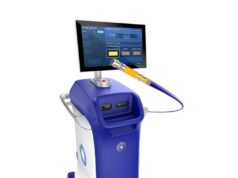The hybrid procedure, which combines a transvenous endocardial and a thoracoscopic epicardial approach in a single ablation procedure, is associated with a 83% success rate at one year in patients with atrial fibrillation, a study, the first to describe this procedure, published in the Journal of American College of Cardiology has found.
Laurent Pison, Department of Cardiology, Maastricht University Medical Centre and Cardiovascular Research Institute, Maastricht, The Netherlands, and others reported that they performed the “hybrid” procedure in 26 patients (10 with persistent atrial fibrillation, one with long-standing persistent, and 15 with paroxysmal atrial fibrillation). They reported: “The pulmonary veins were mapped with a circular mapping catheter. Antral isolation of the right pulmonary veins as a pair was performed with four to six applications using a bipolar radiofrequency catheter” and added that left pulmonary vein isolation was conducted using a similar approach. After this, a roof line and an inferior line were made epicardially using a bipolar radiofrequency pen or linear pen device. If the endpoint for the pulmonary vein ablation was entrance and exit block was not achieved, the conduction gaps were identified endocardially and ablated with a 3.5mm tip catheter.
The one-year success rate, as defined by the Heart Rhythm Society, European Heart Rhythm Association, and European Cardiac Arrhythmia Society (freedom from atrial fibrillation, atrial flutter, or atrial tachycardia lasting more than 30 seconds, off antiarrhythmic drugs) was achieved in 93% of patients with paroxysmal atrial fibrillation and 90% of patients with persistent atrial fibrillation. As two of the patients who were in sinus rhythm after one year underwent catheter ablation for recurrent atrial fibrillation or left atrial flutter after the hybrid procedure, the single-procedure success rate (no antiarrhythmic drugs and/re-do procedures) at one year was 79% for patients with paroxysmal atrial fibrillation and 90% for patients with persistent atrial fibrillation. Pison et al noted that there was an “overall single-procedure success rate of 83% at one year.” No deaths, no conversions to cardiopulmonary bypass, and no patient demonstrated paralysis of the phrenic nerve were reported.
The investigators stated the combination of simultaneous surgical and transvenous catheter ablation have the “potential of treating atrial fibrillation with a single ablation procedure.” They added that the “robustness” of the hybrid technique “lies in its complementary nature, as represented by the fact that in almost a quarter of patients, catheter ablation was needed to finish incomplete epicaridal surgical lesions by endocardial touch-ups.”
Pison told Cardiac Rhythm News: “The next step is the launch of a randomised prospective trial to compare the results of the hybrid approach with conventional catheter ablation in patients with persistent or long-standing persistent atrial fibrillation.”









